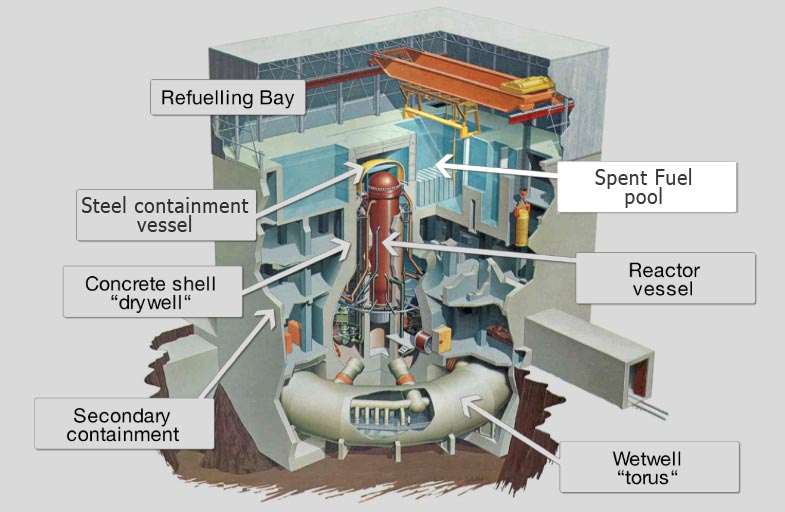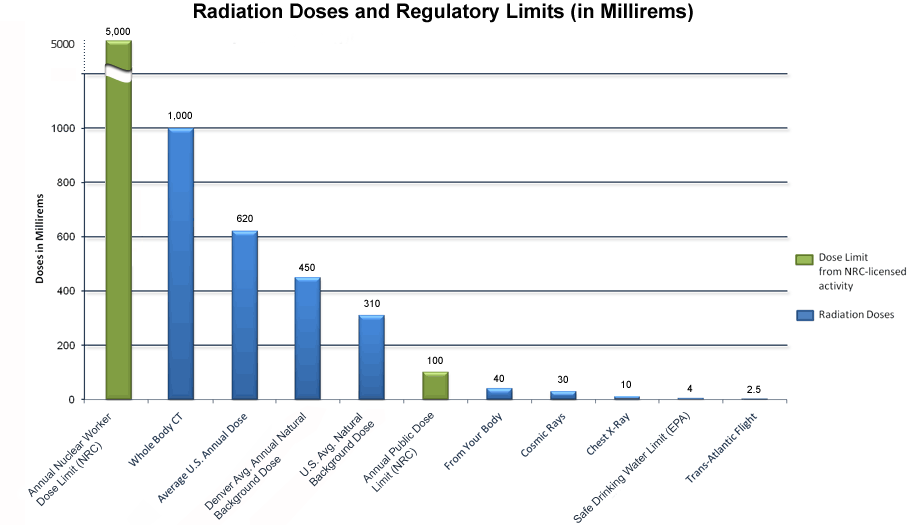
The Fukushima Event (Updated 05/18/2011) - Update information in RED
The Fukushima event is slowly building to become the most significant event in the history of nuclear power. I will continue to update this page to cover all aspects of this event and also to relate this event to US reactors. Please stop back when you can.
May 13
IAEA provided a major update on the Fukushima reactors.
Week of April 11
April 11 update: According to MSNBC, the Japanese government's nuclear safety agency raised the crisis level of the Fukushima Dai-ichi power plant accident from 5 to 7, the worst on the international scale and on par with the Chernobyl accident 25 years ago. Japan earthquake One month on, Japan rattled by big aftershock Somber ceremonies mark a month since tsunami Japan to stop pumping radioactive water into sea NYT: Nuclear disaster reveals Japan temps' plight Millions of yen turned in, Japanese police say Aftershock in Japan unnerves traumatized nation Time-lapse of aftershocks Images of chaos, destruction Kyodo news agency said the government's Nuclear Safety Commission has estimated the amount of radioactive material released from the reactors in Fukushima, northern Japan, reached a maximum of 10,000 terabequerels per hour at one point for several hours, which would classify the incident as a major accident according to the INES scale.
What Happened
An earthquake of magnitude 9 occurred at 2:46 PM on March 11, 2011 about 80 miles out in the Pacific Ocean east of Sendai, Japan. That earthquake resulted in a tsunami over 40 feet high which hit the Fukushima Daiichi plant. Units 1, 2 and 3 were operating. Units 4, 5 and 6 were shutdown. All of Unit 4's reactor fuel load had been placed in the Unit 4 spent fuel pool. Subsequent to the original earthquake, numerous additional quakes have occurred.
The plant's diesel generators started when the loss of offsite power (LOOP) occurred. About an hour later, the diesel generators became unavailable. LOOP events are very infrequent but can have high safety significance. In this case, the diesel generators could not be easily restored. Such an event is considered a Station Blackout. US plant procedures usually consider such an event would likely last up to 8 hours. As a result, the decay heat in the recently shutdown reactors 1, 2 and 3 and the Unit 4 spent fuel pool, which contained the recently discharged full core offload of spent fuel, caused the cooling system temperatures to rise. Eventually the temperatures rose to the point that increased water evaporation or boiling occurred. Eventually the spent fuel was uncovered and the fuel temperatures rose because water flow was not removing the heat. Eventually, fission product gases passed through the zircaloy cladding. Temperatures above 2200F are considered undesireable. Eventually, the steam interacted with the zircaloy to produce hydrogen gas. Water/steam mixtures (with gases) passed from the reactor through pressure relief valves to the torus (also called suppression pool) which contains water. Fission product gases and hydrogen built up in the drywell. In turn, the pressure buildup in the drywell resulted in the operators determining the need to reduce pressure. When that was done, hydrogen was released to the Reactor Building where a hydrogen explosion occurred. An excellent seminar presentation, Nuclear Crisis in Japan , provided by Dr. Alan Hanson on March 21 at the Stanford University's Freeman Spogli Institute for International Studies presented an analysis based on information received to date.
Design Basis of Nuclear Plants
This nuclear plant was designed in the 1960s. While earthquakes and tsunamis were considered in the design, events of this magnitude were not considered.
Current Status
Current status of the event is provided on the following websites:
International Atomic Energy Agency - Fukushima Nuclear Accident Update Log - IAEA Top Stories and Features
Tokyo Electric Power - Updates
Japan Nuclear & Industrial Safety Agency - Updates
Japan Atomic Industrial Forum - Updates
Credible information about the Fukushima event may be obtained from the following websites.
NHK News - NHK News
Nuclear Energy Institute - Nuclear Energy Institute Background Information on Fukushima
New York Times - NY Times search - fukushima nuclear - Plant Status
Reuters - Reuters search - fukushima
Wall Street Journal - Wall Street Journal - Japan's Quake Effects from Today back to Day 1 (Graphics)
Graphics
Several news organization have produced some good graphics and videos about the event. See the following:
Washington Post Videos
Videos and Graphics (NEW on 05/18/2011)
Amorphous News (A video archive of TEPCO video releases)
TBS News Live Camera Fukushima (Chrome browser is recommended since it can automatically translate if desired)
Reactors

Courtesy IAEA
There are 6 reactors at the Fukushima Daiichi site: Unit 1 is a BWR-3, Units 2 through 5 are BWR-4s, and Unit 6 is a BWR-5.
BWR is the abbreviation for the Boiling Water Reactor. The BWR reactor typically allows bulk boiling of the water in the reactor. The operating temperature of the reactor is approximately 570F producing steam at a pressure of about 1000 pounds per square inch. Current BWR reactors have electrical outputs of 570 to 1300 MWe and are about 33% efficient.
Reproduced by permission
In the figure above, water is circulated through the Reactor Core picking up heat as the water moves past the fuel assemblies. The water eventually is heated enough to convert to steam. Steam separators in the upper part of the reactor remove water from the steam.
The steam then passes through the Main Steam Lines to the Turbine-Generators. The steam typically goes first to a smaller High Pressure (HP) Turbine, then passes to Moisture Separators (not shown), then to the 2 or 3 larger Low Pressure (LP) Turbines. In the sketch above there are 3 low pressure turbines, as is common for 1000 MWe plant. The turbines are connected to each other and to the Generator by a long shaft (not one piece).
The Generator produces the electricity, typically at about 20,000 volts AC. This electrical power is then distributed to a Generator Transformer, which steps up the voltage to either 230,000 or 345,000 volts. Then the power is distributed to a switchyard or substation where the power is then sent offsite.
The steam, after passing through the turbines, then condenses in the Condenser, which is at a vacuum and is cooled by ocean, sea, lake, or river water. The condensed steam then is pumped to Low Pressure Feedwater Heaters (shown but not identified). The water then passes to the Feedwater Pumps which in turn, pump the water to the reactor and start the cycle all over again.
The BWR is unique in that the Control Rods, used to shutdown the reactor and maintain an uniform power distribution across the reactor, are inserted from the bottom by a high pressure hydraulically operated system. The BWR also has a Torus (shown above) or a Suppression Pool. The torus or suppression pool is used to remove heat released if an event occurs in which large quantities of steam are released from the reactor or the Reactor Recirculation System, used to circulate water through the reactor.
The NRC has provided a good BWR System text on their website. See the page Inside the BWR which illustrates the equipment used.
Spent Fuel Pools
The are seven spent fuel storage pools on the Fukushima Daiichi site, one in each Reactor Building and one central storage building. The pools store fuel removed from the reactor. The page http://www.nucleartourist.com/basics/sfdecay1.htm shows how radioactivity and heat released trend in the spent fuel while stored in the pools. The page http://www.nucleartourist.com/systems/spfuel1.htm shows the various forms of spent fuel storage. An IAEA presentation describes operational considerations in managing spent fuel. See Operational Safety of Spent Fuel (IAEA)
Radiation Exposure
In the US, radiation exposure due to this event should be of little concern. Radiation levels are rarely above background. Radionuclide deposition is being monitored by the Department of Energy and Environmental Protection Agencies, as well as various state agencies, e.g. Washington, Oregon, and California. Data from governmental agencies has been limited. One example of DOE data is provided in a 2010 PowerPoint presentation (Original DOE - Converted to HTML). However, the University of Washington Physics department and University of California Nuclear Engineering department have both been monitoring airborne and liquid concentrations and posting them.
The figure below shows US radiation exposure regulatory limits and typical US radiation exposures.

Courtesy US Nuclear Regulatory Commission
Appendix B, Annual Limits on Intake (ALIs) and Derived Air Concentrations (DACs) of Radionuclides for Occupational Exposure; Effluent Concentrations; Concentrations for Release to Sewerage, of Title 10 Code of Federal Regulations Part 20 (10CFR20), Standards for Protection against Radiation, identifies the regulatory limits for all radionuclides for workers and the public. Concentration limits in air and water for releases from nuclear power plants are presented in Table 2. As an example, click for I-131 and Cs-137 limits. To relate these limits to the data you may see in the news, 1E-10 microcuries per milliliter (mci/ml) is the same as 100 picocuries per ml (pci/ml) or 3.7 Becquerel/ml or 3.7E-3 Becquerel/m3).
Converting Units
Reporting on radiation dose, radionuclide concentrations for the Japanese reactor event has typically been expressed in the SI (metric) system of units. Units of measurement are:
The US nuclear industry typically uses the original units not SI units.
The size modifiers for each of these units are:
References
IAEA
NRC
Radiation Exposure
Chronology Of Congressional Hearings Related To Radiation And Human Research,
National Security Archive, The George Washington University, http://www.gwu.edu/~nsarchiv/ . Use search for radiation experiment
Earthquake
Earthquake Hazards Program, US Geologic Service, http://earthquake.usgs.gov/
The Pacific Northwest Seismic Network, http://www.pnsn.org/welcome.html
Copyright © 1996-2011. The Virtual Nuclear Tourist. All rights reserved. Revised: Wednesday May 18, 2011.